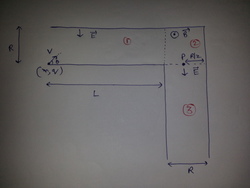Long path
 Diagram shows combination of 3 cuboidal spaces (1,2,3)
1 and 2 contain uniform electric field E, where as 2 contains uniform magnetic field B
Diagram shows combination of 3 cuboidal spaces (1,2,3)
1 and 2 contain uniform electric field E, where as 2 contains uniform magnetic field B
Find out value of E such that the particle enters the magnetic field parallel to x-axis and just passes through point P along the electric field E at that point.
DETAILS AND ASSUMPTIONS
-
Neglect the effect of gravity and consider x-axis parallel to L
M = √ 3 k g
V = 2 s e c m
q = 1 C
L = 2 m
θ = 3 0
The answer is 1.5.
This section requires Javascript.
You are seeing this because something didn't load right. We suggest you, (a) try
refreshing the page, (b) enabling javascript if it is disabled on your browser and,
finally, (c)
loading the
non-javascript version of this page
. We're sorry about the hassle.
1 solution
Also why you complicated the solution. You could directly use
Half Range = L = 2 g e f f v 2 s i n ( 2 θ )
where g e f f = m q E and get the answer
Log in to reply
I've used this only to obtain relation between r and L
Log in to reply
But in this question since the values of R and B are not given Talking about R is waste of time.
Log in to reply
@Ronak Agarwal – You're right but i wanted to describe complete motion in all 3 spaces that's why
Log in to reply
@Kïñshük Sïñgh – So you should ask other things in the questions too. Infact this question can be made much harder by mixing all the things a bit.
Log in to reply
@Ronak Agarwal – Yeah, I'm thinking of this thing only.. This question could be made much harder than this..I'll try to improve these flaws in my future questions.. Do you want to give some suggestions??
Log in to reply
@Kïñshük Sïñgh – You try my question real life applications in geometry.
Log in to reply
@Ronak Agarwal – I don't have any knowledge about latitude and all.. So first of all I've to prefer Internet then I'll try to attempt
Log in to reply
@Kïñshük Sïñgh – Infact I have given the reference of wikipedia in the solution.
@Kïñshük Sïñgh – Also you don't told me you have a B2 subscription.
Log in to reply
@Ronak Agarwal – Yea... But it's of no use...:D
Easy question.
Log in to reply
Yeah i kno...this is the first question which I've made
Log in to reply
How did you attempted the question "solve for trajectory again" what was your approach in solving it.
Log in to reply
@Ronak Agarwal – Earlier i was not aware of such type of questions but when you have posted that 'solve for trajectory' i tried that but i was not able to solve it.. Then, i went through your solution. So my approach was similar for 'solve for trajectory again'
In space 1, motion of particle will be projectile motion just the gravitational force will be replaced by force due to electric field. Therefore, can say that
L = 2 q E m v 2 s i n 2 Θ where acceleration is equal to m q E
In space 2 motion will be circular due to magnetic field as shown in the figure. Therefore, Max height reach by the particle will be equal to R/2
2 R = 2 q E m V 2 ( s i n Θ ) 2 E = q R m V 2 ( s i n Θ ) 2
As we know, t a n Θ = L R (by using formula of max height and and half range) Therefore using these and eliminating R
E = 2 q L m V 2 s i n 2 Θ = 1 . 5